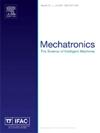Compensating hysteresis and mechanical misalignment in piezo-stepper actuators
IF 3.1
3区 计算机科学
Q2 AUTOMATION & CONTROL SYSTEMS
引用次数: 0
Abstract
Piezo-stepper actuators enable accurate positioning through the sequential contraction and expansion of piezoelectric elements, generating a walking motion. The aim of this paper is to reduce velocity ripples caused by parasitic effects, due to hysteresis in the piezoelectric material and mechanical misalignments, through suitable feedforward control. The presented approach involves the integration of a rate-dependent hysteresis model with a position-dependent feedforward learning scheme to compensate for these effects. Experimental results show that this approach leads to a significant reduction in the velocity ripples, even when the target velocity is changed. These results enable the use of piezo-stepper actuators in applications requiring high positioning accuracy and stiffness over a long stroke, without requiring expensive position sensors for high-gain feedback.
压电步进执行器的补偿滞后和机械错位
压电步进驱动器通过压电元件的连续收缩和膨胀来实现精确定位,从而产生行走运动。本文的目的是通过适当的前馈控制来减少由压电材料的滞后和机械错位引起的寄生效应引起的速度波动。所提出的方法包括将速率相关的滞后模型与位置相关的前馈学习方案相结合,以补偿这些影响。实验结果表明,即使目标速度发生变化,该方法也能显著减小速度波动。这些结果使得在需要长行程的高定位精度和刚度的应用中使用压电步进致动器,而不需要昂贵的高增益反馈位置传感器。
本文章由计算机程序翻译,如有差异,请以英文原文为准。
求助全文
约1分钟内获得全文
求助全文
来源期刊

Mechatronics
工程技术-工程:电子与电气
CiteScore
5.90
自引率
9.10%
发文量
0
审稿时长
109 days
期刊介绍:
Mechatronics is the synergistic combination of precision mechanical engineering, electronic control and systems thinking in the design of products and manufacturing processes. It relates to the design of systems, devices and products aimed at achieving an optimal balance between basic mechanical structure and its overall control. The purpose of this journal is to provide rapid publication of topical papers featuring practical developments in mechatronics. It will cover a wide range of application areas including consumer product design, instrumentation, manufacturing methods, computer integration and process and device control, and will attract a readership from across the industrial and academic research spectrum. Particular importance will be attached to aspects of innovation in mechatronics design philosophy which illustrate the benefits obtainable by an a priori integration of functionality with embedded microprocessor control. A major item will be the design of machines, devices and systems possessing a degree of computer based intelligence. The journal seeks to publish research progress in this field with an emphasis on the applied rather than the theoretical. It will also serve the dual role of bringing greater recognition to this important area of engineering.
 求助内容:
求助内容: 应助结果提醒方式:
应助结果提醒方式:


